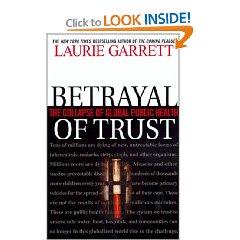It merits emphasis that the author's first conclusion, spanning a diversity of case studies, is that technology may be a catalyst but it rarely drives a revolution in military affairs–concepts are revolutionary, it is ideas that break out of the box.
Their second conclusion is both counter-intuitive (but based on case studies) and in perfect alignment with Peter Drucker's conclusions on successful entrepreneurship: the best revolutions are incremental (evolutionary) and based on solutions to actual opponents and actual conditions, rather than hypothetical and delusional scenarios of what we think the future will bring us. In this the authors mesh well with Andrew Gordon's masterpiece on the rules of the game and Jutland: we may be best drawing down on our investments in peacetime, emphasizing the education of our future warfighters, and then be prepared for massive rapid agile investments in scaling up experimental initiatives as they prove successful in actual battle.
The book is noteworthy for its assault on fictional scenarios and its emphasis on realism in planning–especially valuable is the authors' staunch insistence that only honesty, open discussion among all ranks, and the wide dissemination of lessons learned, will lead to improvements.
Finally, the authors are in whole-hearted agreement with Colin Gray, author of Modern Strategy, in stating out-right that revolutions in military affairs are not a substitute for strategy as so often assumed by utopian planners, but merely an operational or tactical means.
This is a brilliant, carefully documented work that should scare the daylights out of every taxpayer–it is nothing short of an indictment of our entire current approach to military spending and organization. As the author's quaintly note in their understated way, in the last paragraph of the book, “the present trend is far from promising, as the American government and armed forces procure enormous arsenals only distantly related to specific strategic needs and operational and tactical employment concepts, while continu[ing], in the immortal words of Kiffin Rockwell, a pilot in the legendary First World War Lafayette Escadrille, to ‘fly along, blissfully ignorant, hoping for the best.'”
Review: Virtual Reality–The Revolutionary Technology of Computer-Generated Artificial Worlds – and How It Promises to Transform Society
5 Star, Asymmetric, Cyber, Hacking, Odd War, Change & Innovation, Complexity & Resilience, Consciousness & Social IQ, Culture, Research, Decision-Making & Decision-Support, Education (General), Future, Information Society, Information TechnologyReview: Bombs, Bugs, Drugs, and Thugs–Intelligence and America’s Quest for Security
5 Star, Asymmetric, Cyber, Hacking, Odd War, Crime (Corporate), Crime (Government), Crime (Organized, Transnational), Intelligence (Government/Secret)The opening quotation from Harry Howe Ransom says it all-“Certainly nothing is more rational and logical than the idea that national security policies be based upon the fullest and most accurate information available; but the cold war spawned an intelligence Frankenstein monster that now needs to be dissected, remodeled, rationalized and made fully accountable to responsible representatives of the people.”
Professor Johnson is one of only two people(the other being Britt Snider) to have served on both the Church Commission in the 1970's and the Aspin-Brown Commission in the 1990's, and is in my view one of the most competent observer and commentator on the so-called U.S. Intelligence Community. The book is a tour d'horizon on both the deficiencies of today's highly fragmented and bureaucratized archipelago of independent fiefdoms, as well as the “new intelligence agenda” that places public health and the environment near the top of the list of topics to be covered by spies and satellites.
Highlights of this excellent work, a new standard in terms of currency and breadth, include his informed judgment that most of what is in the “base” budget of the community should be resurrected for reexamination, and that at least 20% of the budget (roughly $6 billion per year) could be done away with-and one speculates that this would be good news to an Administration actively seeking trade-offs permitting its promised tax cut program. His overviews of the various cultures within the Central Intelligence Agency, of the myths of intelligence, and of the possibilities for burden sharing all merit close review.
He does, however, go a bridge too far while simultaneously rendering a great service to the incoming Administration. He properly identifies the dramatic shortfalls in the open source information gathering and processing capabilities of the various Departments of the Federal government-notably the Department of State as well as the Department of Commerce and the various agencies associated with public health-but then he goes on to suggest that these very incapacities should give rise to an extension of the U.S. Intelligence Community's mission and mandate-that it is the U.S. Intelligence Community, including clandestine case officers in the field and even FBI special agents, who should be tasked with collecting open sources of information and with reporting on everything from disease to pollution. This will never work, but it does highlight the fact that all is not well with *both* the U.S. Intelligence Community *and* the rest of the government that is purportedly responsible for collecting and understanding open sources of information.
On balance I found this book to be a very competent, insightful, and well-documented survey of the current stresses and strains facing the U.S. national intelligence community. The conclusion that I drew from the book, one that might not be shared by the author, was that the U.S. Government as a whole has completely missed the dawn of the Information Age. From the National Security Agency, where too many people on payroll keep that organization mired in the technologies of the 1970's, to the U.S. State Department, which has lost control of its Embassies and no longer collects significant amounts of open source information, to the White House, where no one has time to read-we have completely blown it-we simply have not adapted the cheap and responsive tools of the Internet to our needs, nor have we employed the Internet to share the financial as well as the intellectual and time burdens of achieving “Global Coverage.” More profoundly, what this book does in a way I have not been able to do myself, is very pointedly call into question the entire structure of government, a government attempting to channel small streams of fragmented electronic information through a physical infrastructure of buildings and people that share no electronic connectivity what-so-ever, while abdicating its responsibility to absorb and appreciate the vast volumes of relevant information from around the globe that is not online, not in English, and not free.
Review: Present Dangers–Crisis and Opportunity in American Foreign and Defense Policy
5 Star, Asymmetric, Cyber, Hacking, Odd War, Terrorism & Jihad, Threats (Emerging & Perennial)Well-footnoted and indexed, this is a very serious professional contribution to the rather lackluster national discussion about where our national security and foreign policy should be going. As one who previously advocated a change from 2+ major regional conflicts (MRC) to 1 MRC and three separate forces for dealing with crime, environmental and cultural movements, and electronic and economic warfare (1+iii), I am now fully persuaded, mostly by the Kagan's book “While America Sleeps” but also by this book, that we absolutely must go toward a 2+iii national security strategy.
My one concern about this book is that it completely ignores what is quaintly called Program 150-all that State Department, Peace Corps, Agency for International Development stuff. It also mentions intelligence and counterintelligence only in passing. Conservative internationalists clearly have the brain power and the strategic vision and the historical understanding to be vital protectors of America's interests, but they must expand their vision to go beyond guns and consider the potential contributions of both diplomatic and economic butter, and applied intelligence. There is in fact a need to have a very strong Presidential program that fully advances, in an integrated fashion, American investments in diplomacy, defense, transnational crime fighting, economic assistance including a Digital Marshall Plan, and cultural exchanges worthy of a great Nation. This book lacks an appreciation for all the “soft” stuff, but it covers three of the four bases very nicely. A “strong buy.”

Review: Betrayal of Trust–The Collapse of Global Public Health
4 Star, Asymmetric, Cyber, Hacking, Odd War, Atlases & State of the World, Complexity & Catastrophe, Corruption, Culture, Research, Disease & HealthIt took me over a month to do justice to this book, and I have taken into account the thoughts of other reviewers. A book of this importance would indeed have benefited from an international advisory board of public health, medical, insurance, and policy experts; it would certainly have benefited from greater structure, firmer editing, and a foreword by someone like a former Surgeon General of the United States. As it is, it appears to have overcome these deficiencies with hyped-up marketing and sweetheart reviews, and this in some ways counterproductive because this book could have, should have, become a mainstream topic in the Presidential campaign. It failed to do so for several reasons, not least of which is the propensity of both candidates and their advisors to avoid serious thinking, but also because the book is not helpful to a popular understanding of the very real global and domestic threats to the health of our children today and in future generations. Having said all this, I commend the book for its content and do not recommend it as avocational reading. There are some very important points that the book brings out, and I will itemize these in order of importance: 1) Public health is about detection and prevention, medicine is about remediation. In the long run, investments in public health are vastly cheaper and more effective than after-the-fact medical intervention; 2) The insurance industry in the developing world has failed to support public health investments, and in a remarkable collusion with the pharmaceutical, hospital and managed health care industries, has created a very expensive and increasingly ineffective system focused on drugs (to which diseases are increasingly resistant) and hospitals; 3) Hospitals are no longer reliable in terms of protecting patients from both error and secondary infection from other patients. People are coming out of hospitals, in many cases, with more diseases than when they went in; 4) The health of our nation depends on the health of all other nations-not only does a collapse of public health in Africa lead to failed states and forced migrations, but it also is but an airline flight away from infecting Kansas; 5) Clean drinking water, uninfected food, and good environmental and occupational health conditions are at risk in many parts of the United States and Europe, not only in Russia and the rest of the world; 6) The United Nations, and the World Health Organization in particular, are in disarray and ineffective-in large part because of a lack of support from member nations-at dealing with the public health commons. There is no question but that the author has hit a “home run” in terms of describing the harsh reality of epidemics in India and Africa, the collapse of public health in Russia, the rapid migration of many diseases from Russia through Germany to the rest of Europe and the U.S., and the severe costs in the U.S. of a retreat from the collective good with respect to public health. Unfortunately, it is a home run hit in isolation, not a game-winning home run, because it fails to drive home, to the only audience that matters-the U.S. voter-exactly what political and economic initiatives are required to achieve three simple objectives: 1) re-establish the public health infrastructure in the U.S.; 2) redirect the entire health care industry toward preventive measures-including water and food quality controls-instead of remedial prescriptions; and 3) provide compelling incentives to the rest of the world for cleaning their own house (this presumes that we are able to clean our own first, a very questionable assumption at this point in time). This is a valuable book, a five in terms of intent, a three in terms of execution, and I am glad that I took the time to read it. It provides a wonderful foundation for enjoying, at an intellectual and policy level, the medical and public health novels by Robin Cook.









